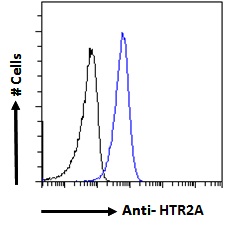HTR2A Antibody (internal region)
Peptide-affinity purified goat antibody
- SPECIFICATION
- CITATIONS
- PROTOCOLS
- BACKGROUND

Application
| FC, E |
|---|---|
| Primary Accession | P28223 |
| Other Accession | NP_000612.1, 3356 |
| Predicted | Human |
| Host | Goat |
| Clonality | Polyclonal |
| Concentration | 0.5 mg/ml |
| Isotype | IgG |
| Calculated MW | 52603 Da |
| Gene ID | 3356 |
|---|---|
| Other Names | 5-hydroxytryptamine receptor 2A, 5-HT-2, 5-HT-2A, Serotonin receptor 2A, HTR2A, HTR2 |
| Dilution | FC~~1:10~50 E~~N/A |
| Format | 0.5 mg/ml in Tris saline, 0.02% sodium azide, pH7.3 with 0.5% bovine serum albumin |
| Storage | Maintain refrigerated at 2-8°C for up to 6 months. For long term storage store at -20°C in small aliquots to prevent freeze-thaw cycles. |
| Precautions | HTR2A Antibody (internal region) is for research use only and not for use in diagnostic or therapeutic procedures. |
| Name | HTR2A (HGNC:5293) |
|---|---|
| Synonyms | HTR2 |
| Function | G-protein coupled receptor for 5-hydroxytryptamine (serotonin) (PubMed:1330647, PubMed:18703043, PubMed:19057895, PubMed:21645528, PubMed:22300836, PubMed:35084960, PubMed:38552625). Also functions as a receptor for various drugs and psychoactive substances, including mescaline, psilocybin, 1-(2,5-dimethoxy-4- iodophenyl)-2-aminopropane (DOI) and lysergic acid diethylamide (LSD) (PubMed:28129538, PubMed:35084960). Ligand binding causes a conformation change that triggers signaling via guanine nucleotide- binding proteins (G proteins) and modulates the activity of downstream effectors (PubMed:28129538, PubMed:35084960). HTR2A is coupled to G(q)/G(11) G alpha proteins and activates phospholipase C-beta, releasing diacylglycerol (DAG) and inositol 1,4,5-trisphosphate (IP3) second messengers that modulate the activity of phosphatidylinositol 3- kinase and promote the release of Ca(2+) ions from intracellular stores, respectively (PubMed:18703043, PubMed:28129538, PubMed:35084960). Beta-arrestin family members inhibit signaling via G proteins and mediate activation of alternative signaling pathways (PubMed:28129538, PubMed:35084960). Affects neural activity, perception, cognition and mood (PubMed:18297054). Plays a role in the regulation of behavior, including responses to anxiogenic situations and psychoactive substances. Plays a role in intestinal smooth muscle contraction, and may play a role in arterial vasoconstriction (By similarity). |
| Cellular Location | Cell membrane; Multi-pass membrane protein. Cell projection, dendrite {ECO:0000250|UniProtKB:P35363}. Cell projection, axon {ECO:0000250|UniProtKB:P14842}. Cytoplasmic vesicle {ECO:0000250|UniProtKB:P14842}. Membrane, caveola {ECO:0000250|UniProtKB:P14842}. Presynapse {ECO:0000250|UniProtKB:P14842} |
| Tissue Location | Detected in brain cortex (at protein level). Detected in blood platelets. |

Thousands of laboratories across the world have published research that depended on the performance of antibodies from Abcepta to advance their research. Check out links to articles that cite our products in major peer-reviewed journals, organized by research category.
info@abcepta.com, and receive a free "I Love Antibodies" mug.
Provided below are standard protocols that you may find useful for product applications.
References
Effects of the serotonin 5-HT2A and 5-HT2C receptor ligands on the discriminative stimulus effects of nicotine in rats. Zaniewska M, McCreary AC, Przegalinski E, Filip M. Eur J Pharmacol. 2007 Oct 1;571(2-3):156-65. Epub 2007 Jun 13. PMID: 17617403
If you have used an Abcepta product and would like to share how it has performed, please click on the "Submit Review" button and provide the requested information. Our staff will examine and post your review and contact you if needed.
If you have any additional inquiries please email technical services at tech@abcepta.com.













 Foundational characteristics of cancer include proliferation, angiogenesis, migration, evasion of apoptosis, and cellular immortality. Find key markers for these cellular processes and antibodies to detect them.
Foundational characteristics of cancer include proliferation, angiogenesis, migration, evasion of apoptosis, and cellular immortality. Find key markers for these cellular processes and antibodies to detect them. The SUMOplot™ Analysis Program predicts and scores sumoylation sites in your protein. SUMOylation is a post-translational modification involved in various cellular processes, such as nuclear-cytosolic transport, transcriptional regulation, apoptosis, protein stability, response to stress, and progression through the cell cycle.
The SUMOplot™ Analysis Program predicts and scores sumoylation sites in your protein. SUMOylation is a post-translational modification involved in various cellular processes, such as nuclear-cytosolic transport, transcriptional regulation, apoptosis, protein stability, response to stress, and progression through the cell cycle. The Autophagy Receptor Motif Plotter predicts and scores autophagy receptor binding sites in your protein. Identifying proteins connected to this pathway is critical to understanding the role of autophagy in physiological as well as pathological processes such as development, differentiation, neurodegenerative diseases, stress, infection, and cancer.
The Autophagy Receptor Motif Plotter predicts and scores autophagy receptor binding sites in your protein. Identifying proteins connected to this pathway is critical to understanding the role of autophagy in physiological as well as pathological processes such as development, differentiation, neurodegenerative diseases, stress, infection, and cancer.


